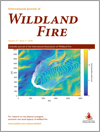International Journal of Wildland Fire
Volume 27
Number 4 2018
A new method, incorporating the Vegetation Difference Index (VDI) and Burn Scar Index (BSI) models, is proposed for burned crops area extraction from satellite images. The VDI reduced the impact of non-farmland information, which in turn improved the accuracy and speed of the BSI model effectively.
Burning biomass generates radiative heat quantifiable remotely as fire radiative power (FRP) and energy (FRE). Fixed-wing aircraft observations miss most of this FRP, resulting in data voids between sampled FRP observations from which FRE is integrated. We present ordinary kriging and Gaussian conditional simulation methods that improve FRE estimation accuracy.
This paper presents an algorithm to automatically locate the fuel burning interface of an active wildfire. Additional outputs are fire perimeter location and rate of spread. The needed input is georeferenced thermal infrared imagery, which can be obtained by airborne platforms. The simplest infrared cameras are suitable because precise radiometric measurements are not required, and neither is multi- or hyperspectral information.
Detailed wind maps are essential to perform accurate wildfire spread simulations. Their computational cost, however, prevent them from being used in data-driven approaches. In this paper we present an interpolation framework to rapidly obtain near-surface wind maps using the WindNinja wind simulator. Results show that this approach speeds up simulation by two orders of magnitude while keeping the error within acceptable bounds.
This paper presents a revised fire behaviour model for spinifex grasslands of arid Australia based on analysis of 186 experimental fires. The two-step model uses wind speed, fuel cover and fuel moisture content to predict the likelihood of fire spread, rate of spread and flame height.
We burned masticated fuelbeds from thinned pine stands in laboratory and prescribed fire experiments. Both coarse and fine fuelbeds burned with low intensity and smouldered for hours, yet the coarse treatments cost less to implement. Mastication is widely applied, and we must plan for when masticated fuels burn in wildfires.




